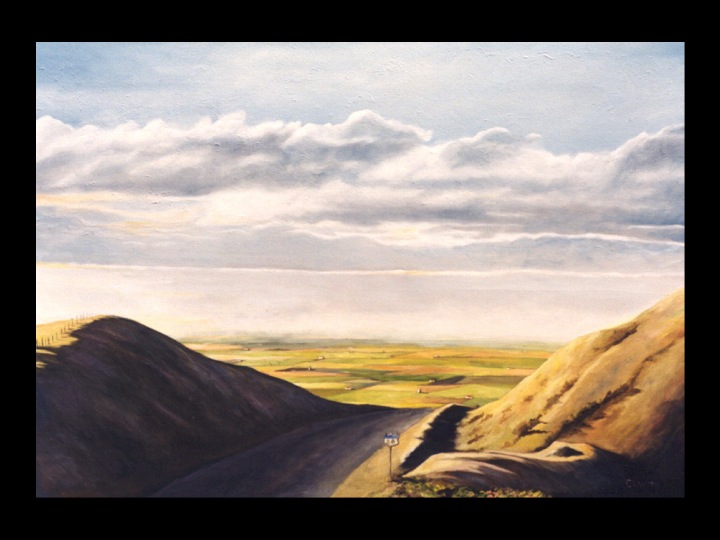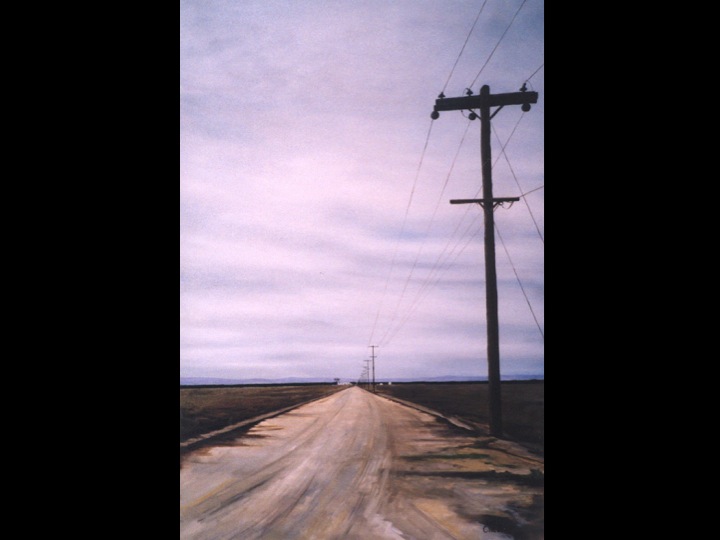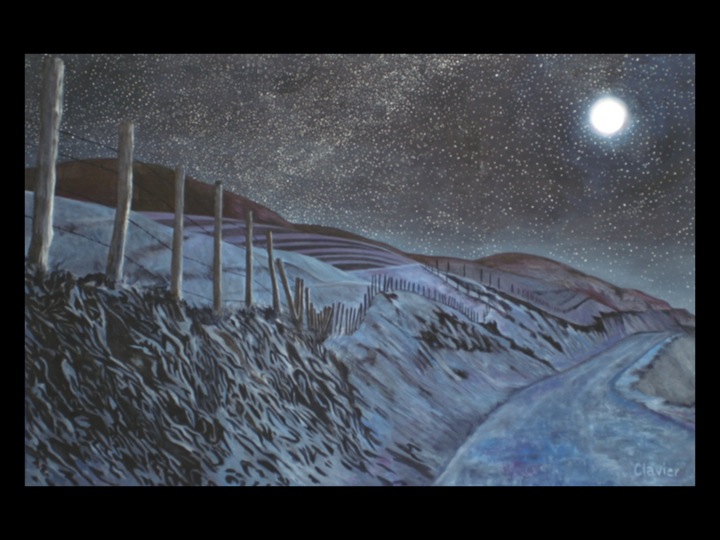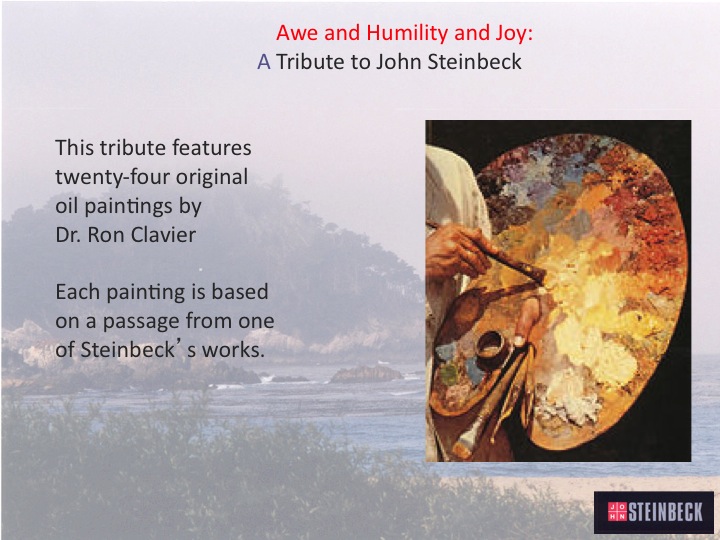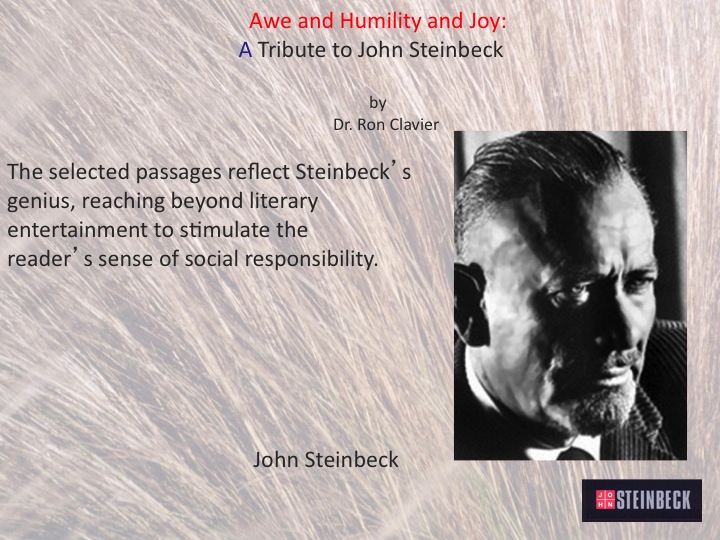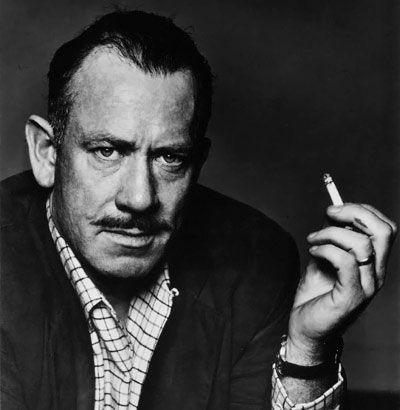Archives for August 2013
Steinbeck’s Home Movies
 Do you like historic films as much as I do? Then you’ve probably seen Of Mice and Men, The Grapes of Wrath, and East of Eden, three classic movies made from books by John Steinbeck soon after they were published. If you love reading Steinbeck’s fiction, you may also be familiar with books about John Steinbeck such as Jackson Benson’s biography, The True Adventures of John Steinbeck, Writer. If you want to see everything imaginable about John Steinbeck in one location—DVDs and documents, books about John Steinbeck and artifacts from the author’s life—the Martha Heasley Cox Center for Steinbeck Studies at San Jose State University is worth a trip. I discovered it almost by accident about a year ago. It got me started reading Steinbeck and eventually led me to the author’s home movies.
Do you like historic films as much as I do? Then you’ve probably seen Of Mice and Men, The Grapes of Wrath, and East of Eden, three classic movies made from books by John Steinbeck soon after they were published. If you love reading Steinbeck’s fiction, you may also be familiar with books about John Steinbeck such as Jackson Benson’s biography, The True Adventures of John Steinbeck, Writer. If you want to see everything imaginable about John Steinbeck in one location—DVDs and documents, books about John Steinbeck and artifacts from the author’s life—the Martha Heasley Cox Center for Steinbeck Studies at San Jose State University is worth a trip. I discovered it almost by accident about a year ago. It got me started reading Steinbeck and eventually led me to the author’s home movies.
Where Classic Movies Meet Books About John Steinbeck
I drove to the Martin Luther King, Jr., Library one afternoon last summer out of curiosity. The library is a big, sleek building at a major intersection in downtown San Jose, and I’d heard that it’s the only public library in America operated jointly by city government and a public university. Inside the atrium I noticed a bank of elevators with signs pointing to special collections on the fifth floor. The ride up provided a dramatic view of the mountains near San Jose. The fifth floor had its own kind of drama. The sound of Beethoven poured from a center devoted to his music, and the California Room looked large, light, and welcoming. But my attention was caught by period posters of classic movies made from books by John Steinbeck, visible through the spacious window of the Martha Heasley Cox Steinbeck Studies Center. I went in and was amazed at what I discovered.
Amidst rows of books about John Steinbeck and objects from the author’s life—including his famous portable typewriter—I encountered Paul Douglass, professor of English at San Jose State University and the director of the Center. He was talking with Peter Van Coutren, the Center’s archivist, but they stopped their conversation to answer my questions. Some academics seem preoccupied or otherworldly. Not Paul and Peter. They’re down to earth, friendly, and available to everyone who walks through the door. Peter pointed out the manuscripts of books by John Steinbeck scrawled in the author’s barely readable writing. Paul commented on several scholarly books about John Steinbeck on display. As I browsed DVDs of Steinbeck’s classic movies and other historic films—including Ken Burns’s documentary on the Dust Bowl—Paul explained how Martha Heasley Cox, a retired English professor, started the Steinbeck collection that now bears her name. Peter and Paul invited me to visit again, and recently I did. But it was the writer’s home movies, not books about John Steinbeck, that brought me back.
How Books by John Steinbeck Led Me to His Home Movies
Between visits I read books by John Steinbeck that inspired three of my favorite historic films, plus books about John Steinbeck as a novelist and screenwriter. I’ve always liked how John Ford directed Henry Fonda as Tom Joad in The Grapes of Wrath, and I love the way Elia Kazan—the director of On the Waterfront and other classic movies—let James Dean improvise the role of Cal Trask in East of Eden. When I drove to California after high school to break into movies, I had James Dean’s image in my mind. Unfortunately both our careers were brief. I ended up working at a restaurant in Los Angeles; Dean was killed in a car crash on the road to Salinas, the setting of East of Eden. After a year, I went home to Florida, where I became a professional photographer and videographer. But I never forgot the beauty of California pictured in classic movies from those books by John Steinbeck. Returning to California to live was my dream, and not long ago it came true. Visiting the Steinbeck Studies Center motivated me to read Of Mice and Men, The Grapes of Wrath, and East of Eden. From there I moved on to books by John Steinbeck set in nearby Monterey. (Remember Hitchcock’s classic movies made in California? The unforgettable mission scene in Vertigo takes place at San Juan Bautista, between Monterey and San Jose.)
Monterey is where I learned about Steinbeck’s home movies, acquired in the 1980s by Robert DeMott, the Center’s acting director after Martha Heasley Cox retired. I no longer work as a videographer, but I still love historic films. When I heard about Steinbeck’s home movies, I read more about his time in Hollywood and his relationship with the makers of other classic movies, including Alfred Hitchcock, who directed Lifeboat and clashed with Steinbeck. I returned to the Steinbeck Studies Center to see for myself how Steinbeck used a movie camera. The Center’s collection includes home movies made by Steinbeck in Monterey as far back as the 1940s, when movie cameras were clunky and you had to be a technician to make one work. Viewing the Center’s DVD sampler of Steinbeck’s home movies gave me a thrill. The visual imagination behind the camera is apparent in scenes that would go viral today. That segment where a curious mouse confronts a caterpillar, for example—most likely filmed at Doc Ricketts’s legendary lab, where Steinbeck liked to hang out with friends and shoot the breeze.
See Steinbeck’s Home Movies for Yourself at the Center
Think what John Steinbeck could do with a smartphone today! As the Center’s sampler shows, his skill with a movie camera was truly impressive. So, by the way, is the Center’s annual John Steinbeck Award. Past winners include Bruce Springsteen and John Mellencamp. This year’s awardee is Ken Burns, the maker of historic films on the Civil War, jazz, Prohibition, the Dust Bowl, and World War II, among other subjects of books by John Steinbeck. Burns will receive the John Steinbeck Award on Friday, December 8, at the San Jose State University Student Union Center. Tickets are still available from Ticketmaster. Why not plan your visit so you can attend the event and sample Steinbeck’s home movies, all in one trip? Admission to the Center is free, and the library is only a short walk from the Student Union. See you there!
Our Possible Other Lives
By Roy Bentley
In one of those my parents don’t meet.
One of them doesn’t leave Kentucky for Ohio,
and their chance street-corner collision in Dayton
is the same primal scream of car traffic but without
all that genuine shock of recognition exchanged.
Maybe my mother had met a man for pie
and was leaving the drugstore soda fountain
when another man, Bobby Burns, back from Korea,
stopped her in front of the theater in Neon, Kentucky
and said that the Fleming-Neon Pirates, the varsity
football team, called to mind a case of hemorrhoids,
which made her grin and answer Yes, Bobby, I’m free
to an invitation to see a movie that night at the Neon.
And maybe the kisses lack something, but she’s tired.
In that life, they marry and I’m born in Kentucky—
or Bobby Burns reads a story in The Mountain Eagle
and says the word Cincinnati like it was the shibboleth
he thought he needed to open the Temple of Dream.
Either way, my mother is in Ohio. My father, too.
Maybe my mother is somewhere buying a novel,
something to read herself to sleep, and so chooses
a big book, The Grapes of Wrath by John Steinbeck.
And so they meet in the street and start something
romantic between them because Bobby Burns
“was no Romeo,” or so she might have explained.
Whatever the case, I’d have been my mother’s son.
The firstborn of a woman denied too much for far
too long not to want everything, and then get it.
For Kate Fox
Robert DeMott’s Typewriter
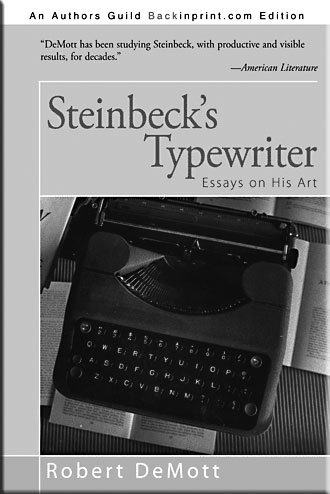 Among the great novels, John Steinbeck books, and artifacts on view at the Center for Steinbeck Studies sits the elegant Hermes typewriter Steinbeck used in Travels with Charley, its surface etched by Steinbeck with the enigmatic phrase: “THE BEAST WITHIN.” It’s there thanks to Robert DeMott, the author of numerous John Steinbeck books and articles and arguably the most original writer about the great novels of John Steinbeck alive today. As the 75th anniversary of the The Grapes of Wrath approaches, Bob is the ideal guide for readers of John Steinbeck books who have lost their emotional connection with the great novels, including The Grapes of Wrath. To recover your lost chord with Steinbeck, go to Steinbeck’s Typewriter by Bob DeMott. This superb collection of essays on The Grapes of Wrath and other John Steinbeck books, first published in 1996, was recently reissued in paperback as An Authors Guild Backinprint.com Edition. Take your time when you read it. Even the footnotes are fascinating.
Among the great novels, John Steinbeck books, and artifacts on view at the Center for Steinbeck Studies sits the elegant Hermes typewriter Steinbeck used in Travels with Charley, its surface etched by Steinbeck with the enigmatic phrase: “THE BEAST WITHIN.” It’s there thanks to Robert DeMott, the author of numerous John Steinbeck books and articles and arguably the most original writer about the great novels of John Steinbeck alive today. As the 75th anniversary of the The Grapes of Wrath approaches, Bob is the ideal guide for readers of John Steinbeck books who have lost their emotional connection with the great novels, including The Grapes of Wrath. To recover your lost chord with Steinbeck, go to Steinbeck’s Typewriter by Bob DeMott. This superb collection of essays on The Grapes of Wrath and other John Steinbeck books, first published in 1996, was recently reissued in paperback as An Authors Guild Backinprint.com Edition. Take your time when you read it. Even the footnotes are fascinating.
The Story Behind a Trio of John Steinbeck Books
In his introduction Bob notes that Steinbeck’s Typewriter completes the trilogy of John Steinbeck books he began with Steinbeck’s Reading (out of print but available on the Steinbeck Studies Center website) and Working Days: The Journals of The Grapes of Wrath, published in 1989 and in print ever since. In a joyful anecdote, Bob explains how he acquired Steinbeck’s typewriter for the Steinbeck Studies Center—along with rare editions of John Steinbeck books, manuscripts, and family memorabilia—while serving as acting director and visiting professor of English at San Jose State University, almost 30 years ago. He tells the story as if it happened yesterday, and its impact still feels fresh. “In my moment of obsessive identification,” he says, “the diminutive machine came alive as a cumulative metaphor for the entire complex of Steinbeck’s working life. . . .”
In my moment of obsessive identification, the diminutive machine came alive as a cumulative metaphor for the entire complex of Steinbeck’s working life.
As this episode suggests, Bob’s approach to the great novels of John Steinbeck is direct, existential, and engaged. Propelled by passion and supported by research, the essays in Steinbeck’s Typewriter are academic in only narrowest sense the word. Instead, as Bob admits, they are “intensely personal, by which I mean they either echo thematic resonances in my own life”—a level of participation in John Steinbeck books that the author of The Grapes of Wrath invited his readers to discover when his books were first read. With astonishing depth and prodigious detail, Bob maps the structure, philosophy, and language of each of the great novels—The Grapes of Wrath, To a God Unknown, East of Eden, and The Winter of Our Discontent—discussed in Steinbeck’s Typewriter. His side excursions are equally compelling—into Steinbeck’s poetry, Steinbeck criticism, and the manuscript mysteries behind The Grapes of Wrath, East of Eden, and The Winter of Our Discontent.
Language and Politics in the Great Novels
An examination of the second draft of The Winter of Our Discontent, for example, “shows that the final thirteen pages of the novel were not in the autograph manuscript but were added by Steinbeck . . . .” A Steinbeck ledger, also studied by Bob at the Pierpont Morgan Library, reveals that Steinbeck planned to write a play-novel on the Cain-Abel theme used in East of Eden as early as 1946, the year his second son was born. The first draft of The Grapes of Wrath helps explain how the greatest of the great novels by Steinbeck was finished so quickly: “When he was hot,” as he was with The Grapes of Wrath, “Steinbeck wrote fast, paying little or no attention to proper spelling, punctuation, or paragraphing.” The typescript of the novel submitted to Steinbeck’s editor reveals that the four-letter words the writer was forced to remove before publication were the usual suspects—with the exception of a six-letter epithet still applied to unpleasant overweight cops.
When he was hot, Steinbeck wrote fast, paying little or no attention to proper spelling, punctuation, or paragraphing.
But Steinbeck’s Typewriter is more than a detective story about manuscripts or a bibliography of John Steinbeck books. In nine substantial essays it explores aspects of background, language, character, and thought encountered in the great novels from To a God Unknown to The Winter of Our Discontent. The echoes of Robinson Jeffers heard in the language of To a God Unknown are amplified by scanning lines from the novel as poetry. The “gruesome experiences, including rape and murder” of Steinbeck’s paternal grandparents in 19th century Palestine “throw some starling new light on East of Eden’s characters.” The Grapes of Wrath is analyzed as a “huge symphony of language,” written while Steinbeck actually listened to Bach, Tchaikovsky, and Stravinsky—with a note that Steinbeck claimed “Edgar Varese the modern composer wants to do [a work] based on one of my books. I wrote him that I thought Grapes might be a theme for a symphony. . . .” The continued relevance of Steinbeck’s protest against “tyranny of surveillance, arrogance of power, and willful destruction of people and resources” in The Grapes of Wrath is underscored by a reminder that Steinbeck’s title was subversive when it was chosen, despite the veneer of patriotism applied after the fact.
A Guide to Greater Participation in John Steinbeck Books
Since 1969 Bob has taught the great novels of John Steinbeck and other American writers at Ohio University, where he is Edwin and Ruth Kennedy Distinguished Professor of English. It’s a remarkable record of achievement and stability. But as a student in the 1960s Bob says he was lost—until reading John Steinbeck books for the first time changed his life for good. “I had almost no direction at all,” he explains. “My life took a marked turn after my first exposure to Steinbeck’s writing. I gained a second chance, which is one way of defining a writer’s gifted appeal and power. . . .” In Steinbeck’s Typewriter Bob suggests how participating in the great novels of Steinbeck is still possible for readers who feel lost in their lives. True, Bob was prepared by circumstance to enter the world of John Steinbeck books with more ease than some. He was born to Italian-American parents and, until he was 8, lived on the estate of Arthur Szyk, a celebrated Polish-American artist with Jewish roots and outspoken views. Today Bob writes poetry, fly fishes with expertise, and lists the monumental Library of America edition of John Steinbeck books among his academic accomplishments. Not everyone has such a resume.
My life took a marked turn after my first exposure to Steinbeck’s writing. I gained a second chance, which is one way of defining a writer’s gifted appeal and power.
Like the great novels of Steinbeck, however, Steinbeck’s Typewriter displays few signs of distance from the experience of ordinary readers. Quite the opposite. Each essay conveys an aspect of Bob’s palpable affection—for John Steinbeck books, for fellow Steinbeck critics, for the class of Steinbeck students who comprise his imagined audience. Most of all he loves Steinbeck’s characters, empathizing with their struggles and understanding them, as the author intended, in every element of their condition. Here is what he dares to write about the notorious ending of The Grapes of Wrath: “This prophetic final tableau scene—often condemned and misunderstood, but for that no less subversively erotic, mysteriously indeterminate—refuses to fade from view; before the apocalypse occurs, before everything is lost in forgetfulness, Steinbeck suggests, all gestures must pass from self to world, from thought to word, from desperateness to acceptance, from participation to communion.” Bob DeMott’s typewriter, like Steinbeck’s, is an instrument of grace—a means of understanding, a mode of deliverance, a way to participate more fully in life through reading. Use it.
The Edward Snowden-John Steinbeck Connection
Edward Snowden, former national security technocrat turned NSA whistleblower. John Steinbeck, 1962 Nobel laureate fiction writer and the subject of FBI files published in 2002. Two famous figures—separated by time, talent, and the tools they used to expose the abuse of political power in their era. Books from John Steinbeck mobilized public opinion on behalf of migrant workers. Emails from Edward Snowden exposed electronic surveillance on a global scale. Both the fiction writer and the NSA leaker risked their safety and traveled to Russia. As the Edward Snowden saga plays out, the story behind the FBI files on John Steinbeck is suddenly relevant again. Two respected books about Hoover and the FBI files show why.
Although the controversy over books from John Steinbeck took longer to reach Washington than reaction to Snowden, public response to the fiction writer in 1939 set off tensions in the White House, with Eleanor Roosevelt and J. Edgar Hoover on opposing sides. As Richard Powers points out in The Life of J. Edgar Hoover: Secrecy and Power (Free Press, 1987), FBI files on liberals like Steinbeck had been used to discredit opponents of the administration as early as 1935. But the systematic surveillance of American citizens actually began in 1914 under Woodward Wilson—like Roosevelt, a progressive Democratic president. Notes Powers: “Hoover vigorously represented throughout his life that population of traditional Americans, largely middle-class, Protestant, and Anglo-Saxon, who were frightened by the changes they felt were depriving them of their privileged position in an ever more pluralistic society.” Hoover was a perfect choice when the time to prosecute pluralists arrived.
How Books from John Steinbeck
Ended Up in Hoover’s FBI Files
John Steinbeck was a California schoolboy with German relatives when Wilson laid the groundwork for the American security state. Hoover, an ambitious young Washington insider, was working at an entry-level job cataloging books for the Library of Congress in 1914. Seven years older than the future fiction writer, he was Steinbeck’s mirror opposite. Like Snowden, he was comfortable with data. Unlike Steinbeck, he was a prim, proper puritan, intolerant of dissent and distrustful of non-whites. A born communist-hunter, he sharpened his skills on suspected German sympathizers as a draft-exempt employee of the United States government.
Days after America declared war on Germany in 1917, Wilson authorized the investigation of German aliens suspected of anti-American sentiment. According to Powers, 4.5 million Americans of German or Austro-Hungarian descent ended up on government lists by the time the war ended. Hoover, a budding bureaucrat with friends in high places, was hired to collect data on potential deportees. As America’s first Red Scare reached its peak following the war, he rose rapidly, becoming acting director of the agency in charge of domestic spying on suspected communists in 1924. When the modern FBI was created in 1935, Hoover was put in charge.
Hoover vigorously represented throughout his life that population of traditional Americans, largely middle-class, Protestant, and Anglo-Saxon, who were frightened by the changes they felt were depriving them of their privileged position in an ever more pluralistic society.
By 1939, with another world war looming, books from John Steinbeck included In Dubious Battle, Of Mice and Men, and The Grapes of Wrath, the three greatest labor novels by any American fiction writer. The Grapes of Wrath provoked animosity from interests with ties to Washington; neither Steinbeck’s growing celebrity nor Eleanor Roosevelt’s public support was enough to protect the fiction writer from Hoover’s FBI. A first-class flatterer, Hoover provided a daily flow of information to President Roosevelt about his political enemies. Political friends like John Steinbeck frequently got caught in the stream.
Lessons from Hoover’s Secret War
On America’s Famous Fiction Writer
How did Hoover win his fight for Roosevelt’s heart? A personal note to the president, penned by Hoover in 1940 at the height of the smear campaign against John Steinbeck, reads like a love letter to the head of a modern totalitarian state. It isn’t hard to imagine how a fiction writer with Steinbeck’s spirit would have reacted if he’d read Hoover’s ass-kissing words to Roosevelt: “In noting the vast contrast between the Leader of our Nation and those of less fortunate nations, I feel deeply thankful that we have at the head of our Government one who possesses such sterling, sincere, and altogether human qualities.” (It’s chilling to consider that Edward Snowden’s present safety depends on a Russian leader surrounded by flatterers like Hoover.)
John Steinbeck and Franklin Roosevelt met for the first time in the fall of 1939. Hoover vetted important visitors for the president, so the FBI files on John Steinbeck probably began as preparation for that meeting—though Hoover denied their existence until the day he died. Yet nothing before 1942 appears in FBI files on the fiction writer. Did Hoover destroy documents to protect Roosevelt? That’s the inference of Top Secret: The FBI Files on John Steinbeck, edited by Thomas Fensch (New Century Books, 2002). What survives from the FBI files on Steinbeck is revealing nonetheless, obsessing about the author’s habits, friends, and beliefs. Books from John Steinbeck were scoured for clues to the writer’s character. Except for references to FBI training in the plot of Steinbeck’s last novel, the FBI files on John Steinbeck say nothing meaningful about the content of his fiction. They attack his motives but ignore his message.
In noting the vast contrast between the Leader of our Nation and those of less fortunate nations, I feel deeply thankful that we have at the head of our Government one who possesses such sterling, sincere, and altogether human qualities.
Those who make Edward Snowden’s motivation the issue rather than the abuses he revealed are following the same playbook today—distraction. That’s why it’s important to examine the FBI files assembled on John Steinbeck under five American presidents for parallels to the present. Roosevelt was no Putin. Nor was Truman, Eisenhower, Kennedy, or Johnson. Ironically, only Richard Nixon managed to reduce Hoover’s power, perhaps because Nixon understood Hoover better than his predecessors in the White House. Remember: Deep Throat—the source of information that helped bring down Nixon’s presidency in 1974,—was a disaffected employee of Hoover’s FBI. Hoover died in 1972, and Deep Throat started talking.
Like John Steinbeck and Edward Snowden, Hoover embodied a personality type found in every era. Steinbecks and Snowdens value liberty over security and elevate the individual above the state. The Hoovers of the world are born authoritarians, gravitating instinctively to power and jealously guarding the status quo. Hoover achieved unprecedented control by collecting secret information, using it to hurt the natural enemies of his peculiar species, including Steinbeck. This conflict for dominance continues in our time, connecting Steinbeck’s story with Snowden’s and Hoover’s FBI with the NSA.
Read more in What the FBI FIles Reveal about Hoover’s War on Steinbeck.
What FBI Files Reveal about Hoover’s War on Steinbeck
As books from John Steinbeck became popular in the 1930s, Europe armed for war. Like Woodrow Wilson in 1914, Franklin Roosevelt was secretly preparing for America’s entry into international conflict by authorizing domestic surveillance in the name of national security. J. Edgar Hoover was only a foot soldier in Wilson’s campaign against German sympathizers in 1917. By the time Roosevelt issued his secret surveillance authorization order in 1936, Hoover was a veteran of the hunt for German sympathizers and the campaign against suspected communists following the end of the war. By 1935, when he was appointed director of the FBI, Hoover had developed a delicate nose for Americans with German or leftist associations. John Steinbeck had both.
As Roosevelt’s chief domestic spy, Hoover believed in fishing with a big net. He understood the benefits of secrecy, data, and dragnet tactics, and Roosevelt’s executive order authorizing secret domestic surveillance allowed him to exercise his talents in all three areas. As Richard Powers explains the situation in The Life of J. Edgar Hoover: Secrecy and Power, “the domestic intelligence apparatus Hoover assembled for Roosevelt [was] part of the president’s covert preparation against the possibility of war, a secrecy made necessary because of the public’s resistance to any attempt to make it realize the true danger of the international situation.” According to Powers, Hoover became “Roosevelt’s effective, loyal, and indispensable agent.” Steinbeck was devoted to the progressive policies of Roosevelt’s New Deal. Hoover was loyal to the pragmatic president in a more personal and practical way.
Fiction Writer vs. Spy in Chief
The FBI files on John Steinbeck—a fiction writer who upset people without really trying—reflect the differences already noted between Hoover and Steinbeck. Hoover equated patriotism with morality and always wore a suit. Steinbeck dressed and lived casually. Hoover never married. Steinbeck had three wives during his lifetime, and according to FBI files the first registered as a communist in 1937. Steinbeck was pro-labor and always sympathized with the underdog. Hoover was anti-union and gravitated to authority. If Hoover read The Grapes of Wrath when Steinbeck’s novel was published in 1939, he probably didn’t like it. The FBI files document his disapproval of the author’s lifestyle.
Do you suppose you could ask Edgar’s boys to stop stepping on my heels? They think I’m an enemy alien. It’s getting tiresome.
In 1942 Steinbeck wrote the letter that made Hoover an enemy for life. Four years earlier California elected the liberal Cuthbert Olson as governor—the state’s first Democratic chief executive since 1895—and Olson named progressive activists like Steinbeck’s ally Carey McWilliams, author of Factories in the Field, to his new administration. Steinbeck’s sense of political progress in California and America, along with his growing reputation as a fiction writer, helps explain the tone of the note Steinbeck sent to Livingston Biddle, Roosevelt’s attorney general and Hoover’s nominal boss, shortly after Pearl Harbor. Steinbeck wanted an Army commission and someone was getting in his way.
Steinbeck’s note to Biddle named Hoover: “Do you suppose you could ask Edgar’s boys to stop stepping on my heels? They think I’m an enemy alien. It’s getting tiresome.” Like Steinbeck, Hoover was a celebrity, and Steinbeck had visited the White House. As a fiction writer with an eye for character and an ear for speech, he might have predicted Hoover’s response to the attorney general: “I wish to advise that Steinbeck is not being and has never been investigated by this Bureau. His letter is returned to you herewith.” Like James Clapper’s public denial of massive electronic surveillance by the NSA, Hoover’s private answer to Biddle was a lie.
The FBI Files Exposed
Hoover interacted at the highest level with military intelligence and never forgot an insult. His hand in keeping Steinbeck out of the Army is revealed in the FBI files on the author. Although the field agent who investigated Steinbeck concluded that the fiction writer was qualified for a commission, this judgment was overridden by the head of military intelligence. Coincidentally, that secretive group had the James Bondian title G-2—one digit away from the name of the intergovernmental economic group meeting soon in Russia. The Obama White House says that Vladimir Putin’s refusal to extradite Edward Snowden won’t prevent the president from attending G-20. John Steinbeck’s reputation as a fiction writer failed to prevent Hoover’s involvement in the verdict of G-2.
Hoover’s retaliation didn’t stop end in 1942. As the FBI files show, books from John Steinbeck and reviews by unfriendly critics were scoured for signs of disloyalty, beginning with The Grapes of Wrath and ending with the author’s last novel, The Winter of Our Discontent.. Agency-inspired citizen-complaint letters contained in FBI files cited Steinbeck’s visits to Russia—both before and after World War II—in impugning the author’s patriotism. Anything remotely connected to Steinbeck’s past went into the FBI files, including fictitious findings by the American Legion Radical Research Bureau, a right wing organization founded during the Red Scare following World War I. Steinbeck was one fiction writer who avoided the reach of McCarthy’s paranoid committee on un-American activities, but he never dropped off the radar screen of Hoover’s FBI.
I wish to advise that Steinbeck is not being and has never been investigated by this Bureau. His letter is returned to you herewith.
J. Edgar Hoover’s private war on America’s foremost fiction writer—a paper war fought with letters, memos, and clippings—was eventually exposed in Top Secret: The FBI Files on John Steinbeck, edited by Thomas Fensch and published in 2002. Hoover died without achieving anything more damaging to Steinbeck than keeping the author out of the Army. In its 75th year, The Grapes of Wrath remains an international icon. Forty years after his death, Hoover has congealed as a symbol of government secrecy and non-judicial overreach detestable to generations of dissenting Americans, beginning with John Steinbeck and continuing in Edward Snowden.
To paraphrase Disraeli on Darwin, Steinbeck was on the side of the whistle-blowers, both as a fiction writer and as a citizen. How Steinbeck would envision the ending of Snowden’s saga is of course unknowable. Given the author’s distrust of Russian dictators, however, it’s safe to assume he wouldn’t like the middle part of the story as it’s unfolding. How we participate in Snowden’s narrative—to paraphrase the fiction writer—is entirely up to us.
Read more in Steinbeck, Snowden, and the Future of America.
Steinbeck, Snowden, and the Future of America
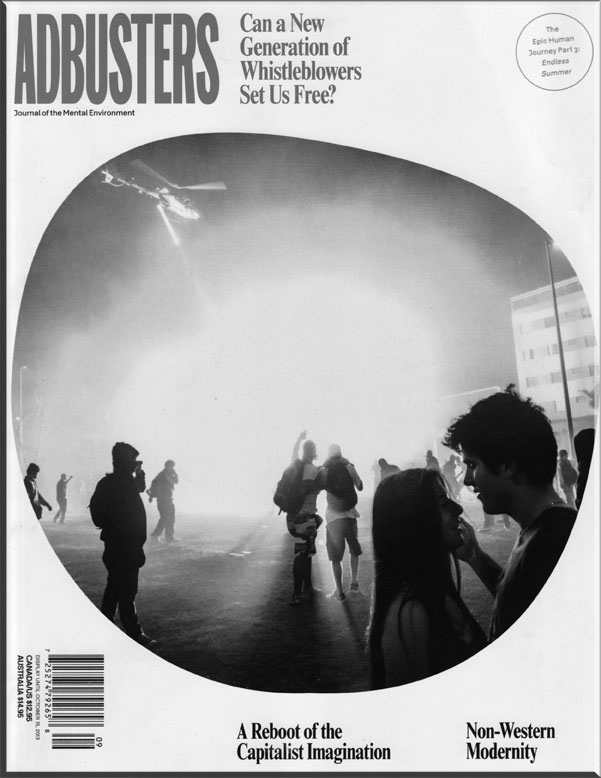 Sinclair Lewis, a Nobel Prize-winning fiction writer admired by John Steinbeck for his dissection of contemporary American life, envisioned a future fascistic America in a novel published the same year J. Edgar Hoover became director of the FBI. Released in 1935, It Can’t Happen Here is a more realistic if less convincing depiction of dictatorial government than George Orwell’s Nineteen Eighty-Four, published in 1949. Books from John Steinbeck about totalitarianism during this turbulent period consist of a slender play-novelette, The Moon Is Down—and it involves enemy invasion, not domestic dictatorship. But based on FBI files and recent events, I believe government surveillance on an Orwellian scale would attract Steinbeck as a subject if he were writing today. His story might start with Hoover.
Sinclair Lewis, a Nobel Prize-winning fiction writer admired by John Steinbeck for his dissection of contemporary American life, envisioned a future fascistic America in a novel published the same year J. Edgar Hoover became director of the FBI. Released in 1935, It Can’t Happen Here is a more realistic if less convincing depiction of dictatorial government than George Orwell’s Nineteen Eighty-Four, published in 1949. Books from John Steinbeck about totalitarianism during this turbulent period consist of a slender play-novelette, The Moon Is Down—and it involves enemy invasion, not domestic dictatorship. But based on FBI files and recent events, I believe government surveillance on an Orwellian scale would attract Steinbeck as a subject if he were writing today. His story might start with Hoover.
Fiction Writer Question: What Would Steinbeck Say?
Also created in 1935, Hoover’s FBI left a blueprint for the kind of American police state imagined by Lewis in It Can’t Happen Here. By blending secrecy, efficiency, and independence from oversight, Hoover built a hidden system of government surveillance years before digital data mining and other tools of the NSA. Hoover’s first speech to the International Association of Chiefs of Police, delivered in 1925, reads like the mission statement for a future NSA security state: “The mighty, irresistible current of world-wide, cosmic forces, have created the necessity and impetus for the inception and growth of an organization which will serve to centralize and crystallize the efforts of those who would meet the exigencies of our changing times by a pooling of all of the wisdom and power of the guardians of civilization, the protectors of Society.”
The differences between Steinbeck and Hoover—in personality, politics, and lifestyle—have already been covered. Richard Powers’ biography, The Life of J. Edgar Hoover: Secrecy and Power, documents Hoover’s deep attachment to moralistic beliefs and dictatorial behavior. Top Secret: The FBI Files on John Steinbeck, edited by Thomas Fensch, demonstrates how easily personal conflicts became public crusades in Hoover’s FBI. If Hoover were still in charge today, Edward Snowden would be caught between deadly opposing forces with identifiably authoritarian faces. Putin or Hoover? Which would be worse for a fugitive like Snowden? Only Richard Nixon rivaled Hoover at creating fear in diissenters, and by 1974 both men had left the stage. Of their odious personality type, only Putin and North Korea’s little caesar remain as players on the international stage.
The mighty, irresistible current of world-wide, cosmic forces, have created the necessity and impetus for the inception and growth of an organization which will serve to centralize and crystallize the efforts of those who would meet the exigencies of our changing times by a pooling of all of the wisdom and power of the guardians of civilization, the protectors of Society.
As noted in Top Secret: The FBI Files on John Steinbeck, America’s foremost fiction writer blew the whistle on Hoover in a private letter to Roosevelt’s attorney general. The immediate consequences to Steinbeck were personal, but they passed. Edward Snowden exposed the NSA’s Orwellian overreach in public, on a global scale, and his consequences are ongoing. Congress is making noise, President Obama says he’ll investigate, and mainstream journalists in America persist in challenging Snowden’s character. To readers of the FBI files on John Steinbeck this all sounds too familiar. It wouldn’t surprise the fiction writer. His experience was similar.
Steinbeck would certainly fear for Snowden’s safety going forward. While he liked Russians, America’s foremost fiction writer hated Stalinism and disliked authoritarians, at home or abroad. He was passionate about democracy but thought the cold war was a political power game threatening human survival. He supported his government in periods of real war but opposed its excesses in times of uneasy peace. Like William Faulkner—another American fiction writer who exalted individual freedom—he gave a Nobel acceptance speech that’s as relevant today as it was it was it was delivered .
For the Answer, Check the FBI Files on the Author
Steinbeck’s speech in 1962 presents an individualist’s answer to authoritarians like Hoover. Steinbeck’s words in his acceptance speech constitute a plausible opening for the anti-totalitarian novel he never wrote: “Fearful and unprepared, we have assumed lordship over the life and death of the whole world of all living things. The danger and the glory and the choice rest finally in man. The test of his perfectibility is at hand.”
In the half-century since Steinbeck delivered his speech, technology and terrorism have intervened in ways that would have horrified the fiction writer. Today the consequences of poking Big Brother in the eye are more serious—and the dimensions of surveillance greater—than he could ever imagine. It required a fiction writer with George Orwell’s direct experience in colonial law enforcement to envision a system of state surveillance anything like today’s NSA. Orwell was supervising an extensive system of domestic surveillance in the British colony of Burma in 1924, the year Hoover became acting director of investigation for the U.S. Department of Justice.
An article in a recent issue of Adbusters magazine speculates that the Orwellian NSA data mining program disclosed by Edward Snowden is only the tip of an iceberg—one that threatens to sink democracy as definitively as the ghastly surveillance system imagined in Nineteen Eighty-Four. Employing the same pastoral image used by Orwell and Steinbeck to portray evil despoiling innocence in fiction, the magazine warns Americans to wake up before escapist slumber becomes actual, existential hell: “America has truly become a nation of sheep . . . . Trust the shepherd. He’ll lead us to pasture.” Overstatement? Only if you think nightmares never come true. If that’s a challenge, try this for size:
Joseph Stalin, the Soviet dictator denounced by John Steinbeck, was an ex-church seminarian who murdered millions of his people. Vladimir Putin, Snowden’s ominous host, formerly ran the KGB, the bloody successor to Stalin’s secret police. Steinbeck’s political hero Roosevelt cooperated with Stalin during World War II. Barack Obama, Snowden’s chief critic and a progressive like Roosevelt, visibly dislikes Putin—but plans to attend Russia’s G-20 conference anyway. Where all this is going is anybody’s guess. John Steinbeck became a hero for exposing economic inequality and injustice in his day. Edward Snowden may become a martyr for revealing massive surveillance in ours. However uncertain the outcome, the connections are clear. Steinbeck’s story suggests history will take Snowden’s side.
William Ray, the editor of five books and former editorial director at New Wedding Planet, is the author of articles on John Steinbeck and the founder of SteinbeckNow.com.
Why John Steinbeck, Novel Writer, Still Rocks
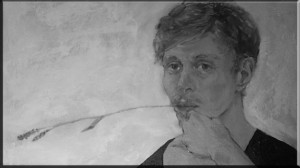 The famous writers of romantic novels still believe in love at first sight. As a visual artist, I have a different perspective from the authors of books of like these. It usually takes at least a second date for me to fall in love with anything, even a novel writer. John Steinbeck was no exception. Three years ago I encountered him for the first time since high school on the shelf of a Goodwill store near my college campus. There it was, a dog-eared copy of East of Eden, waiting for me among castoffs from the authors of books about dating, dieting, and how to use a computer. I remembered reading the novel writer back in high school, so I thought I’d reintroduce myself to the author whose distinctive face presents little challenge for artists who like to paint the famous writers in their particular line of work. I prefer to paint from life, as my self-portrait shown here shows. That’s probably why I fell in love with East of Eden.
The famous writers of romantic novels still believe in love at first sight. As a visual artist, I have a different perspective from the authors of books of like these. It usually takes at least a second date for me to fall in love with anything, even a novel writer. John Steinbeck was no exception. Three years ago I encountered him for the first time since high school on the shelf of a Goodwill store near my college campus. There it was, a dog-eared copy of East of Eden, waiting for me among castoffs from the authors of books about dating, dieting, and how to use a computer. I remembered reading the novel writer back in high school, so I thought I’d reintroduce myself to the author whose distinctive face presents little challenge for artists who like to paint the famous writers in their particular line of work. I prefer to paint from life, as my self-portrait shown here shows. That’s probably why I fell in love with East of Eden.
The famous writers of autobiographical works like East of Eden really open themselves up for inspection. Even a novel writer like Steinbeck, who disliked public exposure, seems to invite readers into his soul when he writes about his own life. Authors of books like Steinbeck’s The Pearl, the entry point into Steinbeck Land for middle school students, seem like easy enough reading when you’re only 14. Of Mice and Men, where the novel writer is less obvious, was a bit harder to understand when I read it in senior high. My reaction to East of Eden in my twenties was a much better experience. The current college crowd favors Fitzgerald and Palahniuk, authors of books worth reading I agree, but the famous writers of Fight Club and The Great Gatsby just don’t have Steinbeck’s depth. As a novel writer for unconventional readers like me, John Steinbeck still rocks where other authors just roll.
East of Eden grabbed me by the hair and shook me from page one. The story of Adam Trask is true fiction—specific to a man who never existed in history, yet symbolic of every sensitive person’s journey through the realities of life. Steinbeck’s unflinching portrayal of Adam’s loneliness and pain is, to me, a portrait of the artist as young man who grows old before my eyes. Adam may not be a hero in the classical sense, but he comes as close as a real human being can. Other authors of books about loss and sacrifice like Adam’s just aren’t as convincing. Real people struggle with daily failure, and Adam fails repeatedly, up until his final utterance—“timshel”—to his surviving son Caleb. After becoming so attached to East of Eden, I picked other books by the novel writer I’d now learned to love. To a God Unknown is probably my favorite, displacing placing Dostoyevsky’s The Devils as an existential portrayal of man at his most spiritual core. Joseph Wayne dies on a rock. Dostoyevsky’s Devils just roll.
The Literary Music of The Grapes of Wrath
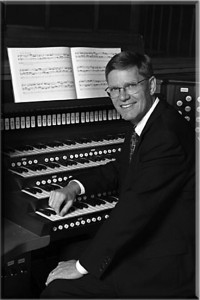 As I was writing my book about the life of Richard Purvis—a California contemporary of John Steinbeck who composed literary music for the organ with a colorful, cinematic character—I was reminded how hard the task faced by writers of books really is. It certainly was for Steinbeck, one of my favorite writers of books on any subject. Steinbeck’s language has always sounded like literary music to my ears, but I wasn’t sure why that was before reading about the background of The Grapes of Wrath. I knew Steinbeck wrote the novel in Los Gatos, not far from Palo Alto, where I live. Recently I learned that he listened to Bach’s Art of the Fugue as he wrote. No wonder the literary music of Steinbeck’s masterpiece conveys such convincing counterpoint. He had Bach’s masterpiece in his head as he was wove the literary music of the Joads, California, and Depression-era America into his great verbal fugue.
As I was writing my book about the life of Richard Purvis—a California contemporary of John Steinbeck who composed literary music for the organ with a colorful, cinematic character—I was reminded how hard the task faced by writers of books really is. It certainly was for Steinbeck, one of my favorite writers of books on any subject. Steinbeck’s language has always sounded like literary music to my ears, but I wasn’t sure why that was before reading about the background of The Grapes of Wrath. I knew Steinbeck wrote the novel in Los Gatos, not far from Palo Alto, where I live. Recently I learned that he listened to Bach’s Art of the Fugue as he wrote. No wonder the literary music of Steinbeck’s masterpiece conveys such convincing counterpoint. He had Bach’s masterpiece in his head as he was wove the literary music of the Joads, California, and Depression-era America into his great verbal fugue.
As a concert organist, I’m used to practicing my art long hours each day. Most writers of books do as well, but Steinbeck wrote The Grapes of Wrath at an incredible pace. Two- to three-thousand words at a sitting is extraordinary, a fact I came to appreciate when I was writing my biography of Purvis. I couldn’t help speculating that certain subjects of Purvis’s literary music, particularly his “Night in Monterey” for organ, would have appealed to the author of The Grapes of Wrath. After all, the literary music of Julia Ward Howe’s “Battle Hymn of the Republic” inspired Steinbeck’s title and was reproduced on the endpapers when the book was published. How many other writers of books ever paid similar homage to a specific piece of music?
I read about how Steinbeck liked listening to Bach in Working Days, the collection of daily journal entries Steinbeck made to warm up before resuming work on The Grapes of Wrath. It occurred to me that, for writers of books, this process is like organists running through scales and arpeggios at the piano before beginning daily organ practice. To make music on the organ—or create literary music at a desk—requires limberness, dexterity, and well-developed skill. So I wasn’t surprised to hear from the organist at Steinbeck’s Episcopal church in Salinas that the author of The Grapes of Wrath took piano lessons as a boy and sang in the children’s choir. Though he attended Stanford University 50 years before I did, Steinbeck and I have much in common. We both like science, enjoy travel, and love Bach and the beach. We’re both from California, a state that has produced distinctive literary music, from Richard Purvis to the Beach Boys, over the years. Other writers of books hailed from sunny California, but for me, none was a literary music maker quite like the author of The Grapes of Wrath.
John Steinbeck Publication, Steinbeck Website Reboot
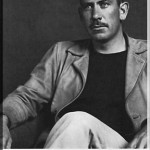 The John Steinbeck publication Steinbeck Review and the Steinbeck website you’re viewing have a new look and new content. Steinbeck Review is now published by The Pennsylvania State University Press in cooperation with the Martha Heasley Cox Center for Steinbeck Studies at San Jose State University. The Spring 2013 issue, edited by Barbara A. Heavilin and Mary M. Brown, features articles about The Wayward Bus, the metaphor of barbed wire in literature, the influence of UCLA philosopher John Elof Boodin on Steinbeck, the 1942 war treatise by Steinbeck’s friend Ed Ricketts, Steinbeck’s Stanford writing teachers Margery Bailey and Edith Mirrielees, the author’s wife Carol Henning, and the banning and celebration of Steinbeck’s works around the world. Effective immediately, searches for johnsteinbeckepiscopalian.org will take viewers to SteinbeckNow.com, a site designed to appeal to readers looking for content relevant to their lives.
The John Steinbeck publication Steinbeck Review and the Steinbeck website you’re viewing have a new look and new content. Steinbeck Review is now published by The Pennsylvania State University Press in cooperation with the Martha Heasley Cox Center for Steinbeck Studies at San Jose State University. The Spring 2013 issue, edited by Barbara A. Heavilin and Mary M. Brown, features articles about The Wayward Bus, the metaphor of barbed wire in literature, the influence of UCLA philosopher John Elof Boodin on Steinbeck, the 1942 war treatise by Steinbeck’s friend Ed Ricketts, Steinbeck’s Stanford writing teachers Margery Bailey and Edith Mirrielees, the author’s wife Carol Henning, and the banning and celebration of Steinbeck’s works around the world. Effective immediately, searches for johnsteinbeckepiscopalian.org will take viewers to SteinbeckNow.com, a site designed to appeal to readers looking for content relevant to their lives.
